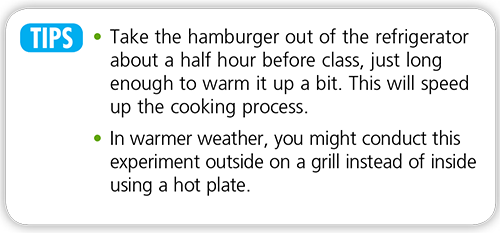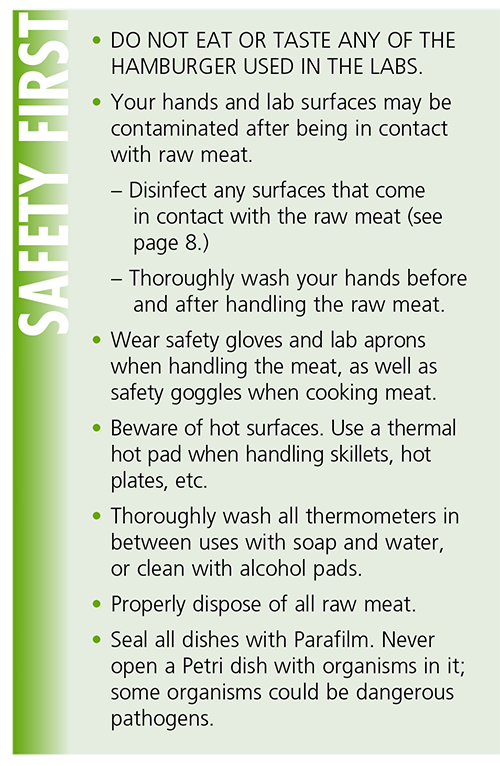Cooking Right: The Science of Cooking a Hamburger (Grades 6-8)
The teacher will demonstrate cooking hamburgers to different temperatures. Students will analyze Petri dishes inoculated with hamburger and observe the amount of bacteria at each temperature. They will also learn that cooking hamburgers to the recommended temperature of 160° F (71° C) will kill pathogenic bacteria. Hamburger is used for this cooking lab because it’s a food that students are familiar with and may be cooking at home.

Background
Lesson Activities
Recommended Companion Resources
Credits
Author
Food and Drug Association (FDA) and National Science Teaching Association (NSTA)
Acknowledgements
The Science and Our Food Supply Curriculum was brought to you by the Food and Drug Administration Center for Food Safety and Applied Nutrition and the National Science Teaching Association.
- FDA Education Team Leader Food Safety Initiative: Marjorie L. Davidson
- FDA Science and Our Food Supply Project Director: Louise H. Dickerson
- FDA/NSTA Associate Executive Director and Science and Our Food Supply Program Director: Christina Gorski
- FDA/NSTA Science and Our Food Supply Program Assistant: Jill Heywood
Standards
Indiana Content Area Standards
-
English Language Arts.Grade 6.SL.1
Listen actively and adjust the use of spoken language (e.g., conventions, style, vocabulary) to communicate effectively with a variety of audiences and for different purposes.
- Comprehension.6.Sl.3.2: Delineate a speakers argument and specific claims, distinguishing claims that are supported by reasons and evidence from claims that are not
-
English Language Arts.Grade 7.SL.1
Listen actively and adjust the use of spoken language (e.g., conventions, style, vocabulary) to communicate effectively with a variety of audiences and for different purposes.
- Comprehension.7.SL.3.2: Delineate a speakers argument and specific claims, evaluating the soundness of the reasoning, relevance, and sufficiency of the evidence.
-
English Language Arts.Grade 8.SL.1
Listen actively and adjust the use of spoken language (e.g., conventions, style, vocabulary) to communicate effectively with a variety of audiences and for different purposes.
- Comprehension.8.SL.3.2: Delineate a speakers argument and specific claims, evaluating the soundness of the reasoning and relevance and sufficiency of the evidence and identifying when irrelevant evidence is introduced.

 It’s particularly important to cook ground meats such as hamburger thoroughly, because there’s a greater chance for bacterial contamination with ground meat than with whole cuts. The bacteria start out on the outside of the meat. When the meat is ground, any bacteria that were originally on the outside can be distributed throughout the hamburger. In addition, when making patties, harmful bacteria from hands, utensils, and surfaces can be transferred to the inside of the hamburger patty. It’s important, therefore, to make sure that the internal temperature of the hamburger has reached a safe internal temperature (160° F [71° C]) to kill foodborne pathogens that may be present.
It’s particularly important to cook ground meats such as hamburger thoroughly, because there’s a greater chance for bacterial contamination with ground meat than with whole cuts. The bacteria start out on the outside of the meat. When the meat is ground, any bacteria that were originally on the outside can be distributed throughout the hamburger. In addition, when making patties, harmful bacteria from hands, utensils, and surfaces can be transferred to the inside of the hamburger patty. It’s important, therefore, to make sure that the internal temperature of the hamburger has reached a safe internal temperature (160° F [71° C]) to kill foodborne pathogens that may be present.